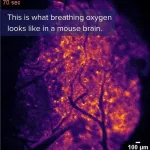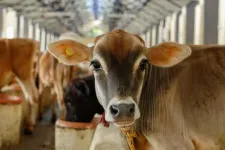(Press-News.org) The dissolved organic matter (DOM) from hundreds of plant and animal remains could be used to track and possibly restore the health of freshwater bodies, Andrew J. Tanentzap and Jérémy A. Fonvielle write in this Perspective. The broad range of compounds, or chemodiversity, of DOM has multiple effects in freshwaters, including providing nutrients to support food web productivity, reducing or enhancing contamination from pollutants, and influencing the metabolism of microorganisms important to the biogeochemical cycle. DOM may also reduce the heat that reaches the deeper, cooler waters that helps to offset some of the impacts of climate warming. Tanentzap and Fonvielle say that high-resolution mass spectrometry can be used to assess freshwater chemodiversity in a way that allows researchers to better pinpoint pollution sources, including those in drinking water, and monitor changes in DOM that could affect freshwater ecosystem health. In one example provided by the authors, DOM chemodiversity analysis was used to determine that a major tributary of Lake Erie shared nearly 30% more organic phosphorus compounds with cropland drainage than with wastewater effluent, leading to the conclusion that inorganic fertilizers were the main source of phosphorus pollution.
END
Dissolved organic matter could be used to track and improve the health of freshwaters
2024-03-28
ELSE PRESS RELEASES FROM THIS DATE:
Indoor air quality standards in public buildings would boost health and economy, say international experts
2024-03-28
There should be mandatory indoor air quality standards, say an international group of experts led by Professor Lidia Morawska.
Professor Morawska, Vice-Chancellor Fellow at the University of Surrey and Distinguished Professor at Queensland University of Technology, led the appeal to the World Health Organization to recognise the airborne transmission of the virus which causes COVID-19 early in the pandemic – and help minimise it.
Now, in a paper published by the prestigious journal Science, Professor Morawska's international team recommends setting standards for ventilation rate and three key indoor pollutants: carbon ...
Positive associations between premenstrual disorders and perinatal depression
2024-03-28
Women affected by premenstrual disorders have a higher risk of perinatal depression compared with those who do not, according to research published March 28th in the open access journal PLOS Medicine. The relationship works both ways: those with perinatal depression are also more likely to develop premenstrual disorders after pregnancy and childbirth. This study suggests that a common mechanism might contribute to the two conditions.
Menstruating women experience cyclical hormone fluctuations through puberty, menstrual cycle, pregnancy ...
New imaging method illuminates oxygen's journey in the brain
2024-03-28
The human brain consumes vast amounts of energy, which is almost exclusively generated from a form of metabolism that requires oxygen. Consequently, the efficient and timely allocation and delivery of oxygen is critical to healthy brain function, however, the precise mechanics of this process have largely remained hidden from scientists.
A new bioluminescence imaging technique, described today in the journal Science, has created highly detailed, and visually striking, images of the movement ...
Researchers discover key gene for toxic alkaloid in barley
2024-03-28
All plants mediate their environmental interactions via chemical signals. An example is the alkaloid gramine produced by barley, one of the world’s most widely grown cereals. Gramine provides protection against herbivorous insects and grazing animals and inhibits the growth of other plants. Despite long-standing interest, the key gene for the formation of gramine remained elusive.
The researchers discovered a cluster of two genes in barley for gramine biosynthesis. The first gene (HvNMT) had already been discovered 18 years ago. In their study the researchers from IPK and the Leibniz University Hannover now identified a second gene (AMI synthase, HvAMIS), and ...
New approach to monitoring freshwater quality can identify sources of pollution, and predict their effects
2024-03-28
The source of pollutants in rivers and freshwater lakes can now be identified using a comprehensive new water quality analysis, according to scientists at the University of Cambridge and Trent University, Canada.
Microparticles from car tyres, pesticides from farmers’ fields, and toxins from harmful algal blooms are just some of the organic chemicals that can be detected using the new approach, which also indicates the impact these chemicals are likely to have in a particular river or lake.
Importantly, the approach can also point to the origin of specific organic matter dissolved in the water, because it has a distinct ...
Bidirectional link between premenstrual disorders and perinatal depression
2024-03-28
Women with premenstrual syndrome (PMS) or premenstrual dysphoric disorder (PMDD) have a higher risk of perinatal depression. Conversely, women with perinatal depression have a higher risk of developing premenstrual disorders. This is shown in a study from Karolinska Institutet published in the journal PLOS Medicine.
Premenstrual disorders like PMS or PMDD and perinatal depression are similar in the way that symptoms appear in connection with hormonal changes. This fact has given rise to the hypothesis ...
Cell division quality control ‘stopwatch’ uncovered
2024-03-28
Each day, hundreds of billions of cells in our body cycle through a period of growth and division. Yet in that time, only about 30 minutes is spent on the critical orchestration of mitosis, when chromosomes are carefully segregated from one parent cell to the next generation of two daughter cells.
It’s during this crucial period of cell division that things can go haywire. Chromosomes can be misdirected, leading to damaged and diseased cells that progress to different types of cancer. University of California San Diego scientists reporting in the journal Science have found a key mechanism that keeps track of mitosis timing and ...
Vaccine protects cattle from bovine tuberculosis, may eliminate disease
2024-03-28
UNIVERSITY PARK, Pa. — Bovine tuberculosis (TB) is a livestock disease that results in large economic losses to animal agriculture worldwide. The disease can also transmit to humans and cause severe illness and death. Researchers from Penn State, Addis Ababa University and the University of Cambridge have now demonstrated that a vaccine for TB currently used in humans significantly reduces infectiousness of vaccinated livestock, improving prospects for elimination and control. The study published today (March 28) in the journal Science.
The spillover ...
Andrew Siemion to receive the SETI Institute’s 2024 Drake Award
2024-03-28
March 28, 2024, Mountain View, CA -- The SETI Institute is pleased to announce that Dr. Andrew Siemion will be honored with the prestigious 2024 Drake Award for his exceptional and pioneering contributions to SETI and radio astronomy and his leadership in the field. Siemion's distinguished career includes his role as the Bernard M. Oliver Chair for SETI at the SETI Institute, Principal Investigator for the Breakthrough Listen Initiative at the University of Oxford, along with holding an Honorary Professorship ...
New study shows how the Crimean-Congo hemorrhagic fever virus enters our cells
2024-03-28
Researchers at Karolinska Institutet, in collaboration with JLP Health and others, have identified how the tick-borne Crimean-Congo haemorrhagic fever virus enters our cells. The results are published in Nature Microbiology and are an important step in the development of drugs against the deadly disease.
Crimean-Congo haemorrhagic fever virus (CCHF virus) is spread through tick bites and can cause haemorrhagic fever. The disease is serious and has a mortality rate of up to 40 per cent depending on the health status of the person infected. Common symptoms ...





